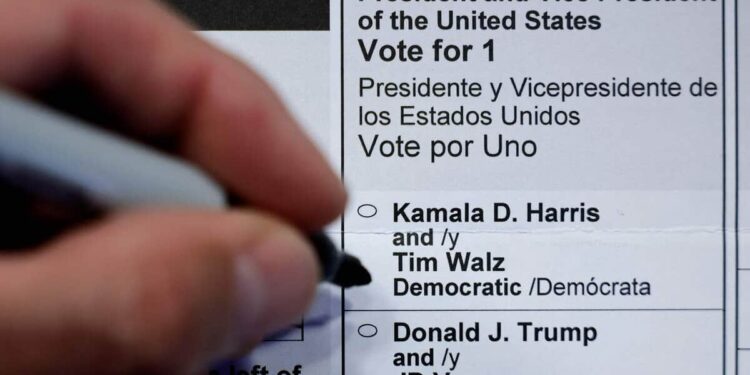Donald Trump victorious over Hillary Clinton in 2016 despite almost three million fewer votes, George W. Bush elected in 2000 against Al Gore who had nevertheless collected almost 500,000 more votes: the American presidential election is based on a very particular system.
• Also read: Why is the American presidential election likely to be played in these seven states?
At the heart of this indirect vote: the electors of the electoral college. In these two examples, the seemingly surprising victory of the Republican candidates can be explained by the fact that they had exceeded the 270 electoral votes necessary to open the doors to the White House.
Some key explanations one week before the election which will pit Donald Trump against Kamala Harris.
Why an electoral college?
The system dates from the Constitution of 1787, which sets the rules for the presidential election according to one-round indirect universal suffrage.
The founding fathers saw it as a compromise between an election of the president by direct universal suffrage and an election by Congress, considered too undemocratic.
Hundreds of proposed amendments to change or eliminate the Electoral College have been submitted to Congress over decades and shock victories, but none have come to fruition.
Who are these major voters?
There are 538 in total. Mostly elected officials and local leaders of their party, their names do not appear on the ballot papers and the overwhelming majority of them are unknown to the general public.
Each state has as many electors as elected officials in the House of Representatives (number determined based on population) and in the Senate (two per state).
For example, California has 55 and Texas 38. Vermont, Alaska, Wyoming and Delaware have only three.
The candidate who wins the majority of votes in a state wins all the electors of that state, except in Nebraska and Maine which distribute their electors proportionally.
Controversial institution
In November 2016, Donald Trump won 306 electoral votes. Millions of Americans called to block it. But only two Texas electors had defected, giving him 304 votes.
This situation was not unprecedented. Five American presidents, in all, have lost the popular vote but won the election. John Quincy Adams was the first, in 1824 against Andrew Jackson.
The famous 2000 election gave rise to an epic imbroglio in Florida between George W. Bush and Democrat Al Gore. The latter had won more votes in the country, but the Republican had garnered 271 votes in the electoral college.
Real vote or simple formality?
Nothing in the Constitution requires electors to vote one way or another.
While some states require them to respect the popular vote, “unfaithful voters” until then most of the time were only exposed to a simple fine. But in July 2020, the Supreme Court ruled that these “disloyal” voters could be sanctioned if they freed themselves from the choice of citizens.
Between 1796 and 2016, there were 180 votes cast against expectations in presidential elections. They never altered the final result on the identity of the tenant of the White House.
When will the vote take place?
The electors will meet in mid-December in their state. On January 6, 2025, following the official count of the votes, Congress will solemnly announce the name of the president. But the result will be known long before.



